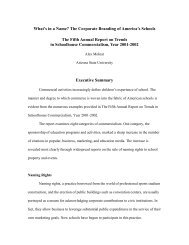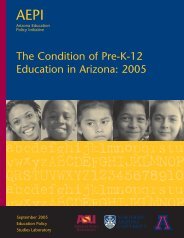The Condition of Minority Access and Participation in Arizona: 2004
The Condition of Minority Access and Participation in Arizona: 2004
The Condition of Minority Access and Participation in Arizona: 2004
Create successful ePaper yourself
Turn your PDF publications into a flip-book with our unique Google optimized e-Paper software.
growth is reduced because m<strong>in</strong>ority children participate less <strong>in</strong> educational activities that<br />
will prepare them to take their place as productive adults <strong>in</strong> <strong>Arizona</strong>’s local economy. As<br />
the non-Hispanic White population comes here to age <strong>and</strong> retire, members <strong>of</strong> that group<br />
argue that they paid taxes to educate their own children <strong>and</strong> do not feel they need to<br />
educate those <strong>of</strong> other families. <strong>The</strong> risk is that, as both <strong>of</strong> these groups grow, the public<br />
will to support public education will dim<strong>in</strong>ish. Little is understood about the impact <strong>of</strong><br />
the chang<strong>in</strong>g demographic environment <strong>in</strong> <strong>Arizona</strong> on public policy <strong>and</strong> on f<strong>in</strong>ancial<br />
support <strong>of</strong> <strong>Arizona</strong>’s schools.<br />
Education policies associated with language m<strong>in</strong>ority participation tend to frame<br />
the issue <strong>in</strong> terms <strong>of</strong> deficiencies <strong>in</strong> the students’ comm<strong>and</strong> <strong>of</strong> English. <strong>The</strong> research<br />
literature, however, <strong>in</strong>dicates that the problem is more complex than a question <strong>of</strong><br />
sociol<strong>in</strong>guistic differences. 43 As much as language differences, socioeconomic (or class)<br />
differences may impede students’ ability to benefit from an <strong>in</strong>structional program that<br />
was not designed with their particular needs <strong>in</strong> m<strong>in</strong>d.<br />
Despite the existence <strong>of</strong> ample data, there has been little productive discussion<br />
that will lead to clear <strong>in</strong>sights <strong>in</strong>to questions such as: (1) What policies, practices, <strong>and</strong><br />
procedures ensure that m<strong>in</strong>ority students feel safe <strong>and</strong> welcome <strong>in</strong> school (2) What<br />
education policy <strong>and</strong> curricular <strong>and</strong> <strong>in</strong>structional practices fit with <strong>in</strong>teraction norms <strong>in</strong><br />
m<strong>in</strong>ority families <strong>and</strong> are relevant to students’ <strong>and</strong> their families’ experiences (3) What<br />
policies, practices, <strong>and</strong> <strong>in</strong>itiatives <strong>in</strong> educational <strong>in</strong>stitutions encourage m<strong>in</strong>ority parents<br />
to feel welcome as advocates for their own children’s education (4) What specific<br />
policies <strong>and</strong> practices <strong>in</strong>crease or decrease the capacity <strong>of</strong> parents, students, <strong>and</strong><br />
education pr<strong>of</strong>essionals to <strong>in</strong>teract reciprocally <strong>and</strong> communicate effectively <strong>in</strong> support <strong>of</strong><br />
students’ persistence <strong>in</strong> K-12 education (5) To what extent do data gather<strong>in</strong>g <strong>and</strong><br />
analysis disaggregate educational achievement, participation, <strong>and</strong> atta<strong>in</strong>ment data with<strong>in</strong><br />
m<strong>in</strong>ority subgroups (for example, dist<strong>in</strong>guish<strong>in</strong>g between recently arrived immigrants or<br />
refugees <strong>and</strong> first- or second-generation m<strong>in</strong>ority students)<br />
Consideration <strong>of</strong> exist<strong>in</strong>g data, conducted <strong>in</strong> t<strong>and</strong>em with reflection on what has<br />
been found to be exemplary educational practice to encourage m<strong>in</strong>ority participation—for<br />
example, the evidence <strong>in</strong> favor <strong>of</strong> bil<strong>in</strong>gual education 44 — will beg<strong>in</strong> to help determ<strong>in</strong>e<br />
5.16





